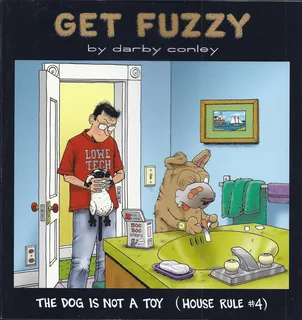Table of Contents
“Get Fuzzy” is a beloved comic strip that has captured readers’ hearts with its witty humor and relatable characters. Created by Darby Conley, the strip debuted in 1999 and quickly became a favorite among comic enthusiasts. Centered on the everyday life of Rob Wilco and his two pets, the strip blends humor, sarcasm, and a touch of reality. In this article, we will delve into the world of “Get Fuzzy,” exploring its origins, characters, impact, and enduring appeal.
1. The Origins of Get Fuzzy: A Comic Strip with Heart and Humor
Darby Conley introduced “Get Fuzzy” in 1999, a time when the comic strip landscape was rich with competition. With a unique blend of sarcasm, humor, and social commentary, “Get Fuzzy” quickly distinguished itself. The strip’s title, a playful twist on the concept of getting cozy, reflects its warm yet mischievous tone. Conley’s background in illustration and love for animals greatly influenced the creation of the strip’s main characters.
From the beginning, “Get Fuzzy” stood out for its clever dialogue and dynamic character interactions. The strip follows the daily life of Rob Wilco, a mild-mannered bachelor who lives with his two pets: Bucky, a cynical and conniving Siamese cat, and Satchel, a kind but often naive Shar-Pei/Labrador mix. This trio’s antics, marked by Bucky’s schemes and Satchel’s innocence, provide the comic strip’s humorous essence.
Conley’s ability to infuse personal experiences and observations into the strip helped “Get Fuzzy” resonate with a wide audience. The strip’s humor often touches on everyday situations, pet-owner relationships, and the quirks of human and animal behaviors. Over the years, “Get Fuzzy” has maintained a consistent following, appealing to readers with its endearing characters and sharp wit.
2. Meet the Characters: Rob, Bucky, and Satchel’s Quirky Dynamics
The charm of “Get Fuzzy” largely lies in its memorable and well-developed characters, each with distinct personalities. Rob Wilco, the human protagonist, serves as the often-exasperated but loving owner of his two pets. He works as a marketing executive, though much of his time is spent dealing with the chaos Bucky and Satchel bring into his life. Rob’s character represents the quintessential pet owner, managing the unpredictable nature of living with animals.
Bucky Katt, the mischievous and self-centered Siamese cat, is the strip’s undeniable troublemaker. His schemes, ranging from petty thefts to elaborate plans for world domination, often drive the strip’s humor. Bucky’s disdain for Satchel, coupled with his high self-regard, creates a constant source of conflict and comedy. Despite his grumpy demeanor, Bucky’s clever one-liners and exaggerated self-importance make him a beloved antihero.
Satchel Pooch, in contrast, is the sweet-natured and slightly clueless dog who balances Bucky’s negativity with his optimism. Satchel’s gentle disposition and eagerness to please often put him at odds with Bucky, who sees him as an easy target. Despite Bucky’s bullying, Satchel remains kind-hearted, providing a refreshing counterpoint to the cat’s cynicism. His innocence and occasional moments of insight add depth to the strip’s humor.
The dynamic between Rob, Bucky, and Satchel forms the heart of “Get Fuzzy.” Their interactions highlight the complexities of pet ownership, the absurdities of everyday life, and the love-hate relationships that often characterize human-animal bonds. Through these characters, Conley creates a comedic yet relatable portrayal of modern living.
3. The Humor of Everyday Life: Get Fuzzy’s Relatable Themes
“Get Fuzzy” masterfully captures the humor in everyday life, drawing on familiar scenarios that resonate with readers. The strip often explores themes like pet misbehavior, domestic disputes, and the small victories and frustrations of daily living. By focusing on these relatable moments, Conley creates a world where readers can see reflections of their own lives, adding to the strip’s enduring appeal.
One of the central themes in “Get Fuzzy” is the unique bond between humans and their pets. The strip highlights the joys and challenges of pet ownership, often exaggerating the quirks of both humans and animals for comedic effect. Rob’s exasperation with Bucky’s schemes and Satchel’s naivety mirrors the experiences of many pet owners who navigate the ups and downs of sharing their lives with unpredictable companions.
“Get Fuzzy” also uses humor to comment on broader social and cultural issues, often through Bucky’s sarcastic observations and satirical rants. Topics like consumerism, environmental concerns, and human folly are cleverly woven into the strip’s narrative, providing a subtle critique of modern society. Conley’s ability to blend lighthearted humor with thought-provoking commentary sets “Get Fuzzy” apart from other comic strips.

The strip’s humor is further enhanced by its clever wordplay, puns, and visual gags. Conley’s talent for creating punchlines that resonate with readers of all ages contributes to the strip’s broad appeal. Whether it’s Bucky’s latest scheme or Satchel’s innocent misunderstandings, each strip delivers a dose of humor that feels both fresh and familiar.
4. Get Fuzzy’s Artistic Style: Visual Storytelling at Its Best
“Get Fuzzy” is not only known for its witty dialogue but also for its distinctive artistic style that complements the storytelling. Conley’s illustrations bring the characters to life, with expressive faces and dynamic poses that capture the strip’s humor. The art style is simple yet effective, using clean lines and bold expressions to convey the characters’ emotions and enhance the comedic timing.
The visual storytelling in “Get Fuzzy” plays a crucial role in setting the tone and pacing of each strip. Conley’s use of panels, positioning, and visual cues creates a sense of movement that makes the interactions between characters feel lively and engaging. The strip’s layout often mirrors the chaos and energy of the characters’ antics, drawing readers into the action.
Conley also uses visual elements to add layers of humor to the strip. Background details, facial expressions, and body language all contribute to the comedic impact, often adding punchlines that are not explicitly stated in the dialogue. This attention to detail elevates “Get Fuzzy” beyond a simple comic strip, making it a rich visual experience that rewards careful observation.
The artistic style of “Get Fuzzy” has remained consistent over the years, retaining its charm and appeal. Conley’s commitment to maintaining the strip’s visual integrity reflects his dedication to the craft and to his audience. As a result, “Get Fuzzy” continues to stand out in the world of comic strips, recognized for both its humor and its distinctive look.
5. The Impact and Legacy of Get Fuzzy in the Comic World
Since its debut, “Get Fuzzy” has made a significant impact on the comic strip world, garnering a loyal fan base. The strip’s unique blend of humor, relatable characters, and social commentary has resonated with readers across generations. “Get Fuzzy” has been featured in numerous newspapers, online platforms, and collected volumes, solidifying its place as a beloved staple of modern comics.
One of the key factors behind “Get Fuzzy’s” success is its ability to connect with readers on a personal level. The strip’s portrayal of the ups and downs of pet ownership, the quirks of everyday life, and the timeless battle of wits between cat and dog are universally relatable. This connection has helped “Get Fuzzy” maintain its popularity, even as the media landscape has evolved.
“Get Fuzzy” has also influenced other creators, inspiring a new generation of comic artists to explore similar themes of humor and relatability. The strip’s success demonstrates the enduring appeal of character-driven storytelling, where the interactions between well-developed personalities create the foundation for humor. Conley’s work serves as a testament to the power of comics to entertain, reflect, and connect.
Despite changes in the comic industry, “Get Fuzzy” has remained a beloved part of many readers’ lives. The strip’s timeless humor, memorable characters, and insightful observations continue to make it a favorite among comic enthusiasts. Its legacy is one of laughter, warmth, and a celebration of the absurdities that make life both challenging and delightful.
6. The Future of Get Fuzzy: Continuing to Delight Readers
Although new strips of “Get Fuzzy” are no longer produced regularly, the comic continues to enjoy a lasting presence. Syndicated reruns keep the characters alive, allowing new readers to discover and enjoy the strip’s humor. The enduring appeal of “Get Fuzzy” lies in its timeless themes and the universal truths it portrays through its charming cast.
Fans of “Get Fuzzy” continue to celebrate the strip through online forums, fan art, and social media discussions. The characters of Rob, Bucky, and Satchel have become icons within the comic world, remembered for their unique personalities and the laughter they bring. As long as there are readers who appreciate clever, character-driven humor, “Get Fuzzy” will remain relevant.
Darby Conley’s contributions to the world of comics extend beyond “Get Fuzzy,” inspiring future artists to explore their creativity. The strip’s legacy serves as a reminder of the power of humor to connect people, make them think, and brighten their days. “Get Fuzzy” continues to be a cherished part of the comic strip landscape, celebrated by fans old and new.
Conclusion
“Get Fuzzy” is more than just a comic strip; it’s a celebration of the quirks, conflicts, and connections that define everyday life. Through its endearing characters, clever humor, and insightful commentary, “Get Fuzzy” has carved out a lasting place in the hearts of its readers. Darby Conley’s creation has transformed mundane moments into comedic gold, proving the power of well-crafted humor to resonate across different audiences. As the comic strip continues to be enjoyed through reruns and collections, its impact endures, demonstrating the timeless appeal of its unique blend of characters and storytelling.
The influence of “Get Fuzzy” extends beyond its comic strips, inspiring adaptations and merchandise that celebrate its beloved characters. Fans have embraced everything from collectible items to themed events, further solidifying the strip’s place in popular culture. Conley’s characters, especially Bucky and Satchel, have become more than just comic personas—they are cultural icons representing the humorous side of human-animal relationships.
Moreover, the strip’s success underscores the importance of authenticity and relatability in storytelling. By capturing the everyday struggles and joys of its characters, “Get Fuzzy” has offered readers a mirror to their own experiences. The humor may be exaggerated, but the emotions and situations are grounded in reality, making the strip both entertaining and poignant.
As we look to the future, the legacy of “Get Fuzzy” will likely continue to inspire new generations of comic artists and writers. The strip’s ability to blend humor with insightful observations provides a model for creating content that resonates deeply with audiences. Darby Conley’s work serves as a reminder of the impact that thoughtful and creative storytelling can have.
In conclusion, “Get Fuzzy” is more than just a comic strip; it is a testament to the enduring power of humor to connect, entertain, and reflect the human experience. Through its clever writing, distinctive art style, and relatable characters, it has left a lasting mark on the comic world. As readers continue to enjoy and celebrate the strip, its influence will undoubtedly persist, proving that great humor never goes out of style.


